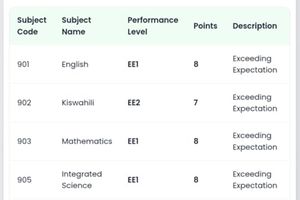Premium
University freshers’ tuition loans and scholarships out

The government has released the results for tuition loans and scholarship applications for first-year university students.
What you need to know:
- Band 1 has students whose monthly income does not exceed Sh5,995 while Band 2 ranges from Sh5,995 to Sh23,670.
- Students from families with monthly incomes between Sh23,671 and Sh70,000 are placed in Band 3.
The government has released the results for tuition loans and scholarship applications for first-year university students, just days before most institutions open.
The results have drawn mixed reactions from students, their families, and other stakeholders, especially regarding how students have been categorised based on family income under the funding model introduced last year.
Following the processing of the applications, universities have started sending amended admission letters indicating the amount of fees students are expected to pay.
“It’s taken too long to communicate this. Up to now, I don’t know how much I’m required to pay for my son, who’s going to the University of Nairobi on Monday. We’ve done some shopping, but on the fees, we’ll cross that bridge when we get there,” Naomi Muthoni, a parent, told the Sunday Nation.
There was a hue and cry when universities earlier released student admission letters that indicated the full amount of fees without factoring in government support. Education Cabinet secretary Julius Ogamba has now given universities up to August 19 to send the amended letters to all first-year students. In a statement, he said 125,893 students out of the 153,275 admitted to universities had applied for scholarships and loans.

However, the Higher Education Loans Board (Helb) and the Universities Fund (UF) have not released the number of students placed in the various bands or the amounts awarded. Higher Education PS Beatrice Inyangala told the Sunday Nation that the distribution of the awards would be released next week “once the exercise is complete because it’s changing constantly”.
The funding model places students in five bands depending on their family income as well as other factors like the size of families and the children in school. Band 1 has students whose monthly income does not exceed Sh5,995 while Band 2 ranges from Sh5,995 to Sh23,670.
Students from families with monthly incomes between Sh23,671 and Sh70,000 are placed in Band 3, while those between Sh70,001 and Sh119,999 are in Band 4. Band 5, which receives the least funding in terms of scholarships but is high on loans, is for students whose families earn above Sh120,000.
In this context, household income refers to the total earnings received by members of a household. It includes wages, salaries, pensions, and proceeds from farming, business, and investments.
According to the 2024 Kenya Economic Survey, the national average monthly earnings per employee in the private sector are Sh57,200, while those in the public sector earn an average monthly income of Sh52,158. This implies that the majority of average Kenyan students are in Band 3.
Apart from the fees that students pay, they also need money for upkeep and accommodation. Many universities do not have adequate internal accommodation, and students are forced to rent outside, where prices are higher. Under the model, the government supports students through scholarships awarded by the UF and tuition and upkeep loans awarded by the Helb.





